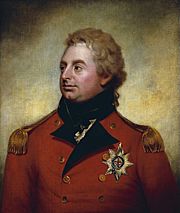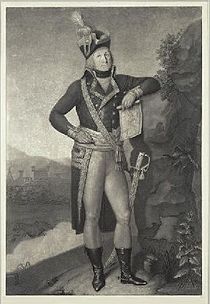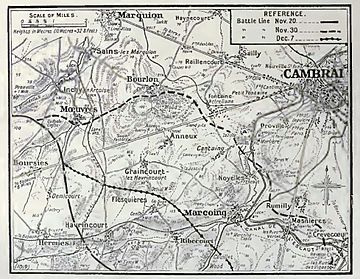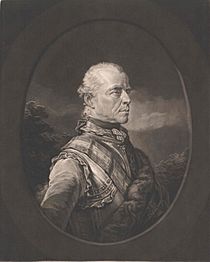Battle of Caesar's Camp facts for kids
Quick facts for kids Battle of Caesar's Camp (1793) |
|||||||
|---|---|---|---|---|---|---|---|
| Part of the Flanders campaign of the War of the First Coalition | |||||||
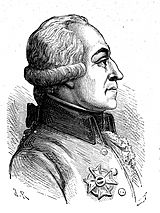 Prince Josias of Saxe-Coburg-Saalfeld planned to crush the French army, but his opponents escaped. |
|||||||
|
|||||||
| Belligerents | |||||||
| Commanders and leaders | |||||||
| Strength | |||||||
| 43,000 | 35,000 | ||||||
| Casualties and losses | |||||||
| light | light, 3 guns | ||||||
The Battle of Caesar's Camp happened on August 7–8, 1793. During this battle, an army of several countries, called the Coalition, tried to surround the French army. The Coalition was led by Prince Josias of Saxe-Coburg-Saalfeld. The French army was led by Charles Edward Jennings de Kilmaine.
The Coalition army had more soldiers. It included troops from Austria, Great Britain, and Hanover. They planned to trap the French army in its fortified camp. However, General Kilmaine was smart. He decided to quietly move his army away towards Arras before the trap closed. This event was part of the War of the First Coalition. It took place near Cambrai, France, and the village of Marquion, which is about 12 kilometers (7.5 miles) northwest of Cambrai.
Before this battle, the previous French commander, Adam Philippe, Comte de Custine, was called to Paris. He was later arrested and executed. Kilmaine was asked to lead the army temporarily until a new commander arrived. The Coalition planned a big attack. Two Austrian groups would attack the front of the French camp. A British and Hanoverian group, led by Prince Frederick, Duke of York and Albany, would march around behind the French army. Even though some French officials wanted Kilmaine to fight, he chose to escape to the west. On August 8, the Coalition's trap closed, but only two French battalions were caught. Even they managed to get away when Kilmaine used his cavalry (soldiers on horseback) to help them. Kilmaine was later removed from command and arrested. However, he was not executed and later served under Napoleon Bonaparte.
Why This Battle Happened
In May 1793, several French cities like Lyon, Marseilles, and Toulon rebelled against the new French government, the First French Republic. At the same time, France was losing battles against other countries. For example, they lost to the Sardinians and the Spanish. Things looked very bad for France.
The government in France was changing. A group called the Jacobins took control from another group called the Girondins. This made the government more extreme.
In May 1793, Prince Coburg's Coalition army defeated the French Army of the North. They then began to besiege Valenciennes. The French commander, Custine, worked hard to make his army stronger. But the Jacobins in power didn't trust officers who had served the old French king. They often criticized Custine. The Minister of War also worked against him.
In July, two important French fortresses, Condé and Mainz, surrendered to the Allies. The city of Valenciennes also surrendered. Because of these losses, Custine was arrested and later executed.
Jean Nicolas Houchard was chosen to replace Custine, but he couldn't take command right away. So, Kilmaine, who had some small successes, was chosen to lead the army temporarily. He arrived in Cambrai on July 15, 1793. The main French army under Kilmaine had about 35,000 soldiers.
After capturing Valenciennes, the Coalition leaders weren't sure what to do next. The Austrians had promised to send 10,000 soldiers to help the Duke of York capture Dunkirk. Prince Coburg, the main Coalition commander, had a different idea. He wanted to move his army southeast and attack another French city. But the Duke of York disagreed. The Austrian Emperor's advisor also wanted the armies to split up. He wanted the Prussians to attack one area, Coburg to attack another, and York to attack Dunkirk. Coburg agreed, but they decided to try and fight a major battle with the French army first.
The Battle Unfolds
Historians say Kilmaine had about 35,000 soldiers defending Caesar's Camp. The French camp was shaped like a square. Its front faced east, protected by the Scheldt River. The fortresses of Bouchain and Cambrai were on its left and right sides. The north side was protected by the Sensée River. The south side was guarded by hills. The west side was protected by the Agache River. The rivers were flooded, and all crossing points were heavily defended.
Prince Coburg planned to completely defeat the French army. On August 6, 1793, the entire Coalition army began to move. The Duke of York led 22,000 men to a meeting point. Another group of soldiers covered York's left side. On August 7, York's group of 25,000 men marched to surround the French southern side. They planned to attack Kilmaine's right rear. Two more groups, totaling 16,000 soldiers, started from another town. These groups aimed to cross the Scheldt River north of Cambrai. Smaller forces were ordered to make fake attacks to distract the French.
It was very hot on August 7, and some soldiers even died from the heat. By evening, the Coalition groups had reached the Scheldt River, but they couldn't cross it that day. York's group crossed the Scheldt after a long march. The soldiers were very tired. That day, Kilmaine used 3,000 French cavalry soldiers to slow down York's march. They made fake attacks, forcing the Coalition to stop and get ready to fight. In the evening, some British cavalry soldiers saw French cavalry. They charged and drove the French away, capturing some prisoners.
Kilmaine realized his army was about to be surrounded. He held a meeting with his officers. One official wanted the French army to leave a small force to watch the Coalition and then attack York's group. After defeating York, they could then turn on the other Coalition groups. Kilmaine argued that his soldiers were too tired for such a complex plan. He also said he didn't have enough cavalry. Instead of retreating towards Paris, Kilmaine decided to retreat west. He planned to set up a new defense behind the Scarpe River, between Arras and Douai. This position would allow his army to threaten any Allied advance towards Paris.
The French army began its retreat at dawn on August 8. When York's group reached a village called Cantaing-sur-Escaut, they found the French were gone. York continued to chase them towards Marquion. He gathered about 2,000 British cavalry soldiers for the chase. When York arrived at Marquion, the French had set buildings on fire and broken the bridge over the Agache River. This was to stop the Coalition from following them. York and some of his men rode through the burning village. They saw some cavalry and thought they were friendly. York rode up to them, saying, "Here are my Hanoverians!" But then he realized they were French! Luckily, one of his officers quickly pulled him back to Marquion.
To get his cavalry across the Agache River, York sent some units south to find another crossing. But that crossing was difficult and took a lot of time. Two French battalions that had retreated appeared. British cavalry chased them into Marquion. They would have been captured, but Kilmaine heard about their trouble. He brought a large force of cavalry and some cannons. The British and French cavalry fought, and the two French battalions managed to escape. The Coalition only captured 3 cannons and 150 prisoners. What the Coalition didn't know was that part of Kilmaine's army panicked that day. As they retreated, soldiers at the front, farthest from the enemy, suddenly ran away. The panic spread, and whole groups of soldiers shouted, "Every man for himself!" and fled. If Kilmaine had not used his cavalry to stop York's cavalry, the French might have suffered a huge defeat.
What Happened Next
After the battle, York returned to Bourlon. He argued with Coburg's chief of staff, Friedrich Wilhelm, Fürst zu Hohenlohe-Kirchberg. York blamed him for the French escaping. The Austrians, in turn, blamed York. One British officer wrote that their army wasn't strong enough to attack the French. He also said York's group was far from help, and they were actually glad to see the French leave.
The Coalition then asked the isolated fortress of Cambrai to surrender. But its governor refused, saying, "I do not know how to surrender, but I know well how to fight."
Kilmaine moved his army to a new position behind the Scarpe River. His right side was at Arras, and his left side was at Douai. Kilmaine found out he was removed from command on August 14. The government was suspicious of him because he had English relatives. Kilmaine said he was loyal to France and that he would be a good cavalry commander. However, his retreat from Caesar's Camp was seen as a bad thing. He was arrested in December 1793. Luckily, he was released later and served under Napoleon Bonaparte, who thought he was a good commander.
After this event, Coburg wanted York to stay and help capture Cambrai or attack the French army again. But York had to follow orders from the British government. At this time, the Allies had many soldiers facing a weak spot in the French defenses. Some historians believe that the French were "at the mercy of the Allies." They think that the Allies splitting their forces saved France from defeat. However, the British government really wanted to capture Dunkirk. The Prussians also decided to take their 8,000 soldiers away from Coburg's army. Coburg stayed and began the Siege of Le Quesnoy, which ended with a French surrender in September 1793. York gathered 37,000 soldiers and marched northwest towards Dunkirk. But the Allied Siege of Dunkirk was a complete failure.
Images for kids


